Seven ways I’m retrofitting my house for energy efficiency in a changing climate
Where I live, it’s getting hotter. This summer we’ve just seen a record-breaking heatwave of six days above 40°C. There’s been a few other records broken, too. Including, the highest number of days over 40°C between December and February – and we are not yet even through January.
Every year we seem to be* (*we are) breaking records.
The climate is changing. And even if we stop global warming in its tracks, the changes that have happened are here to stay, at least in our lifetimes. Zero net zero emissions isn’t going to reverse anything, just slow change down.
Yes, we can write to politicians and march and protest, and we can boycott and change our habits.
But we also need to adapt.
You might have heard talk about “climate resilience”, which is the ability to prepare for and recover from climate-related events such as extreme weather.
Climate resilience needs to happen at all levels, from international treaties to national policy, to local government laws and neighbourhoods and communities working together.
And on a micro level, we need to adapt to become more resilient, too. (Although what that looks like will be different for all of us.)
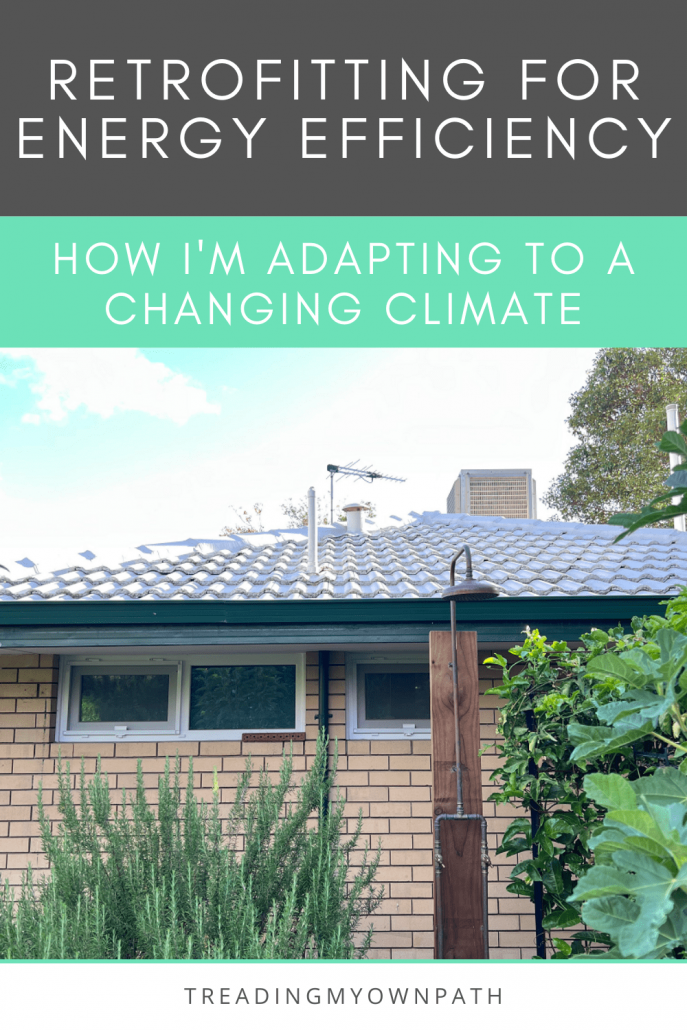
Retrofitting a 1970s house for energy efficiency (heating and cooling)
I don’t have the option to move to a different climate, and I don’t have the funds to build a Grand Designs style solar passive house. (Not that I’d want to, and anyways, new houses might be energy efficient but building them has a big carbon footprint.)
But I own where I live (well technically the bank does, until I repay the mortgage) which means I can make modifications that make my home more energy-efficient and more comfortable to live in.
The changes I’m talking about here are to the building itself, but if you’re a renter, don’t despair. You could ask your landlord if they’d consider making some improvements. If they say no, it’s worth keeping these in mind for your next move so you know what to look out for. Importantly, there are still modifications possible for renters too – I’ll talk about these in another post.
How houses lose and gain heat
Put simply, this is where an average home with no insulation gains/loses heat:
- Ceiling: 25 – 35%
- Floor: 10 – 20%
- Air leaks and draughts: 5 – 15%
- Walls: 10 – 20% loss in winter; 15 – 25% gain in summer
- Windows: 10 – 20% loss in winter; 25 – 35% gain in summer
(Source: yourhome.gov.au )
West Australian houses are particularly leaky. They have little insulation, there are gaps in the door and window frames, they are rarely double or triple-glazed, and are not oriented or designed in a way that suits the climate. Which means they are freezing cold in winter and boiling in summer.
They tend not to have a central heating or cooling system either either. Many houses install split-systems, but usually where its easiest to install rather than where it would be most effective.
Plus, when a house is leaky, you’re paying to heat or cool air that just leaves as soon as it can. Which makes running them inefficient and expensive.
Retrofitting a 1970s house: where I started
This is my home, as I bought it in 2019 (these are the real estate photos – the lawn is long gone!). The house faces north-west. In Perth, the hottest part of the the day is the afternoon (when the sun is to the west), and any windows and walls on the west side will get the hottest.
My house is a duplex (semi-detached) which means the western side is mostly insulated by the other dwelling – and this was a deliberate choice on my part. The one window I have on the north-west side is next to the front door, and is shaded by the garage and other house.
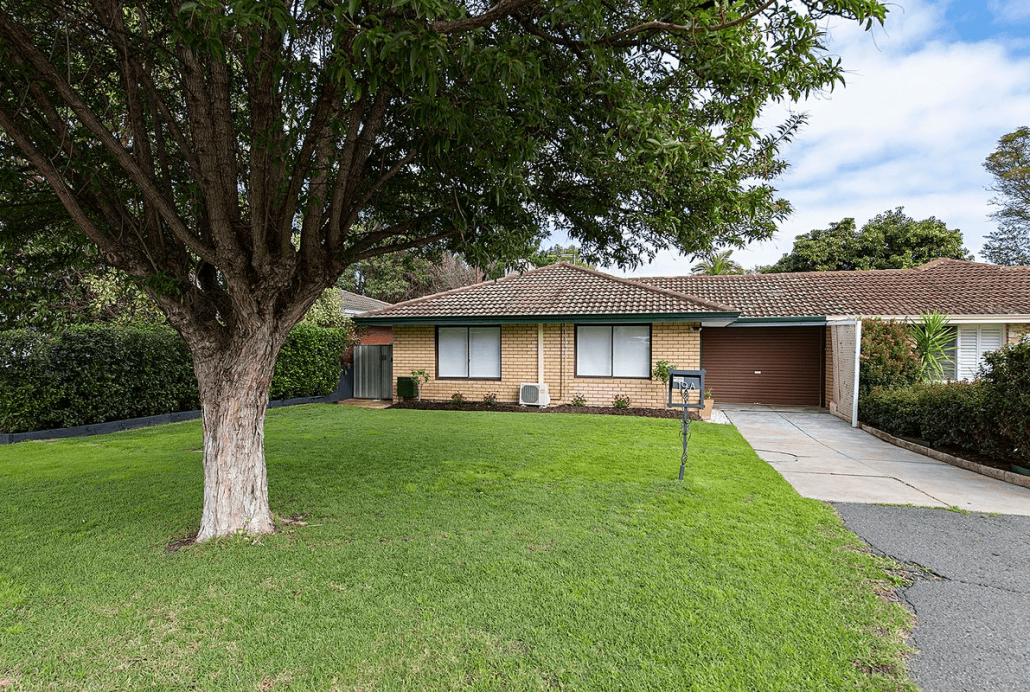
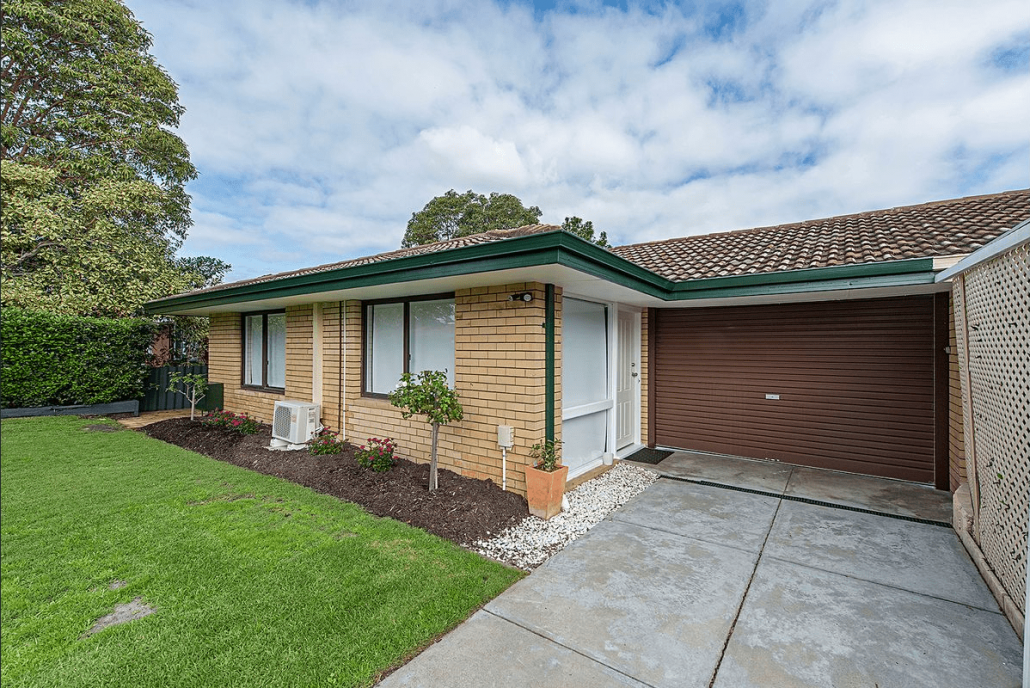
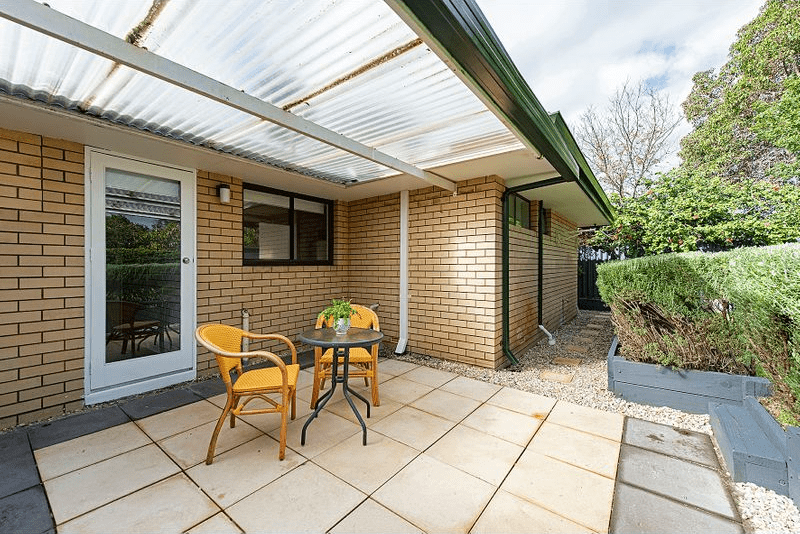
The less windows on the western side, the better.
The three on the south-west side (pictured above) are the kitchen window, which is protected by the patio roof, and the bathroom and toilet windows, which are both small (the less glass, the better).
All of the windows were single-glazed, and the brown frames are aluminium, which is a terrible material for window frames as it conducts heat. The metal gets hot in summer and cold in winter, and allows the heat to enter or leave.
You can’t tell from the picture, but the glass pane of the toilet window was only 3/4. Meaning, there was a gap of a few inches along the top with no glass at all. It’s fairly common in older houses here. This made the toilet freezing in winter and boiling in summer. In fact, that whole half of the house was pretty unbearable on the hottest and coldest days.
You can just make out in the first picture an old metal evaporative air conditioner on the roof. It had been disconnected from the electricity, but the ducting from the roof to the three rooms (living room and two bedrooms) remained.
In hot weather you could stand underneath the vents and feel the heat funnelling in from outside.
And in winter, the heat disappeared through these vents in the ceiling.
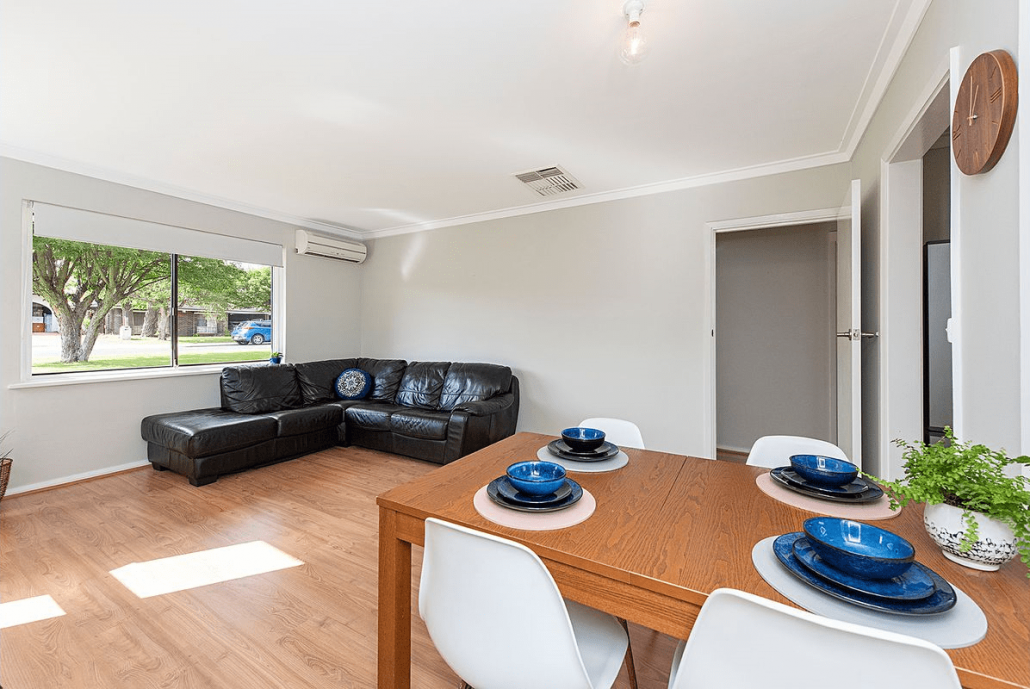
1. Installing solar panels
The very first thing I did when I moved in was install solar panels. And I mean literally: I got the keys on the Friday, and I was getting quotes on Monday morning. One month after I moved in, there were solar panels on the roof.
I’ve talked about installing solar before, so I won’t go into it again in detail, but I now have a 3kW system that faces north-west. My roof is too small for anything bigger, but I don’t really need anything bigger.
Although it’s not strictly retrofitting, I knew that my old house would be leaky (leaking heat) and I wanted solar as soon as possible, so I felt less guilty about using the air con and heating.
Solar panels also help insulate the roof by covering the tiles. It’s probably less useful with metal roofs as metal conducts heat, so the whole thing will heat up, but my tiles are concrete. They absorb heat during the day when exposed to the sun, and radiate it out at night. With solar panels, the tiles under the panels are shaded and protected.

2. Installing ceiling fans
The second thing I did was install ceiling fans in the living room and two bedrooms. My previous house had ceiling fans and they are such an underrated addition to a house – the air movement makes everything feel cooler even without any cooling. And when the windows are open at night or the air con is on, it helps spread the cool air throughout the house.
It’s also a fairly cheap thing to do. I had to pay an electrician to install them, and because there weren’t fans there originally he had to install supports in the roof, but it was a straightforward job. I opted for fans with lights, and just replaced the existing light fittings with the fans/lights so I didn’t end up with holes in the ceiling.
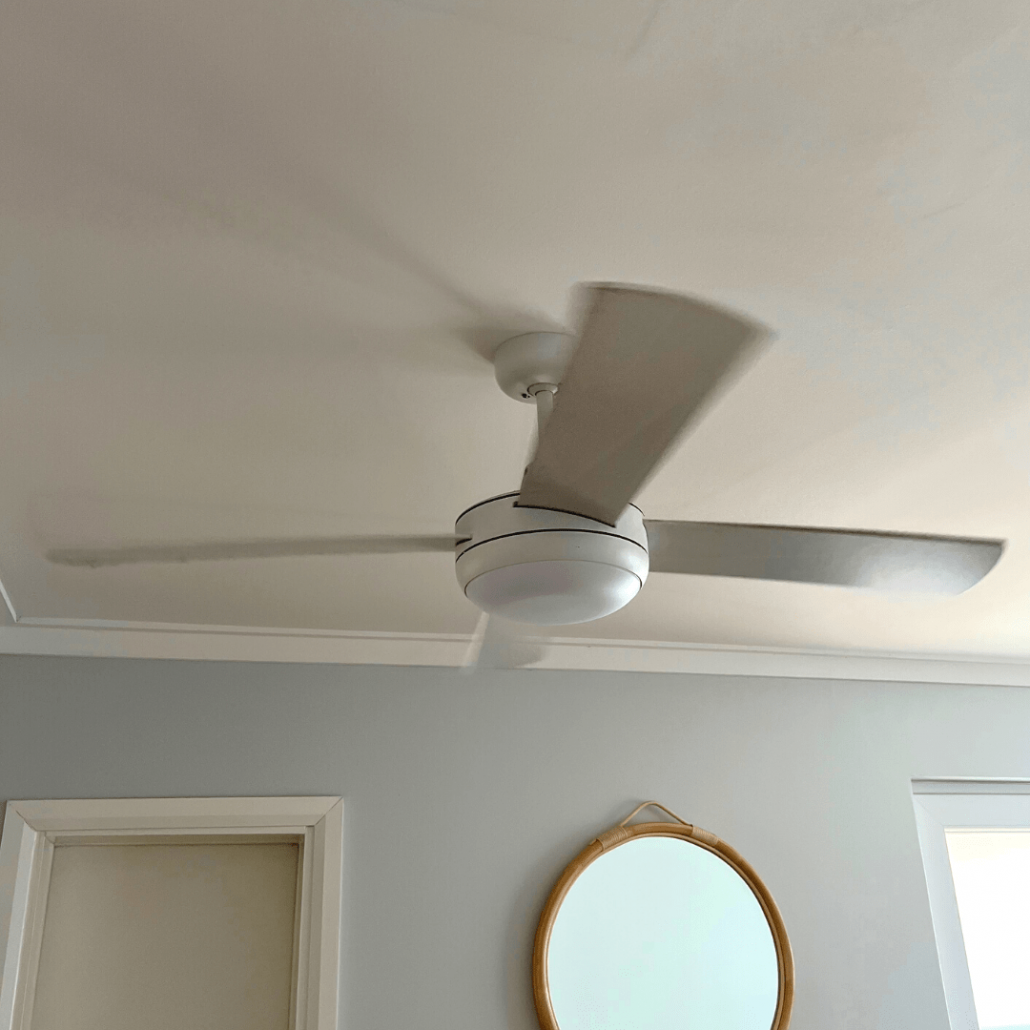
If you don’t have high ceilings (I don’t), just make sure you choose a fan with a shorter drop, as they vary and those few cm will make a difference.
And if you choose fans with lights, make sure you can replace the globes, as some have unchangeable globes – meaning if the bulb blows you need to replace the whole unit, and you will need an electrician to replace it for you. This is both wasteful and expensive!
Ceiling fans are also incredibly cheap to run, because they don’t actually heat or cool. A ceiling fan typically costs the same to run as a single light bulb.
3. Installing double glazing
This was the big one, both in terms of cost and the difference it made to the house. It was installed one year after we moved in, so I had one summer and one winter with the existing windows before the change.
In the summer prior, with both air con units running, it was manageable at the front, and unbearably hot at the back of the house (where the hot western sun beats in the afternoon, and where the toilet window with 3/4 glass and 1/4 gap was located).
In the winter, I had to use a portable heater in the bedroom at the back (the office).
The double glazing replaced all the existing windows except the one in the kitchen (which one day I’d like to knock through into a door – it is very frustrating having to walk through the laundry and around half the building to get to the patio in front of the kitchen window).
Both the external doors (the front door and the laundry door, which was rotten) were also replaced.
There is a door onto the patio from the garage, which has also been left for now.
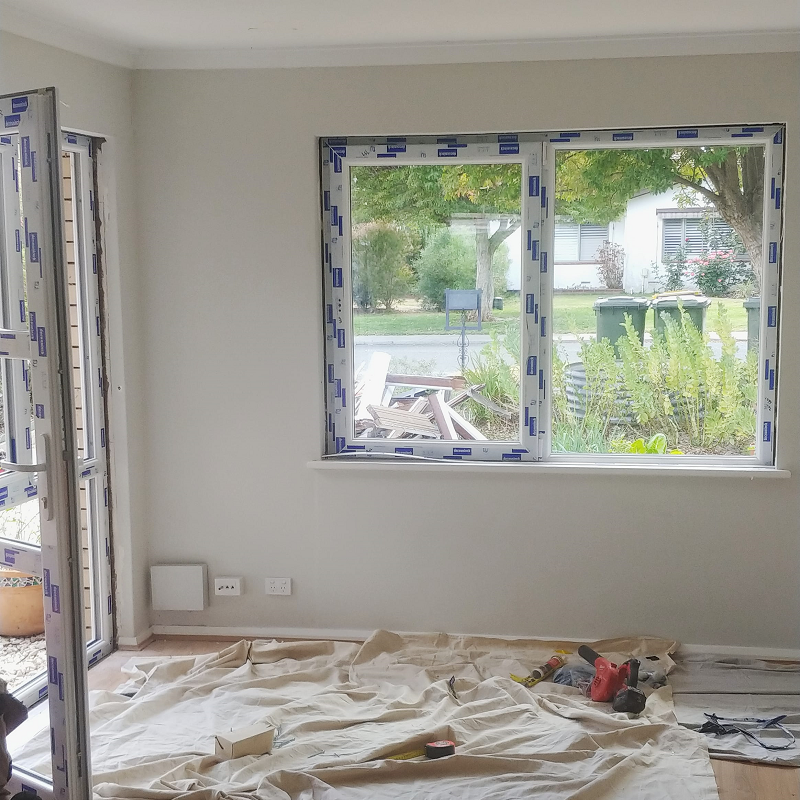
Whilst I’d have loved wooden frames, they don’t seem to be an option in Perth, so the frames I have are PVC. (There is no point choosing aluminium if you want energy efficiency as the frames conduct heat very well – either into or out of the house depending on what you don’t want.)
The glass is Low-E, meaning it’s coated to reduce the amount of infrared and ultraviolet light that enters and performs better than regular glass.
I was planning on triple glazing for the toilet and bathroom because they get so hot, but was talked out of it by the salesperson who said it makes more difference for noise and I wouldn’t need it.
She was right – the double glazing is enough.
With the double glazing installed, the change is amazing. Before, on a 40°C day I’d need the air con running for most of the day. Now, the cool (or in winter, the heat) doesn’t escape, so I can mostly restrict their use to when the solar panels are cranking.
4. Blocking up the ceiling vents
The double glazing stopped a lot of air leaks, which made those that were left all the more noticeable. In particular, the three ceiling vents from the disconnected evaporative cooling system were literal tunnels from the roof, and if you stood underneath them you would feel a blast of hot air coming down.
And of course in winter they let all the heat up and out into the sky.
Did I mention they were also broken, rusted and ugly?
A temporary fix would have been to put cardboard (or something more solid) inside the vents to block them up. The permanent solution was to block them with gyprock and remove the ducting.
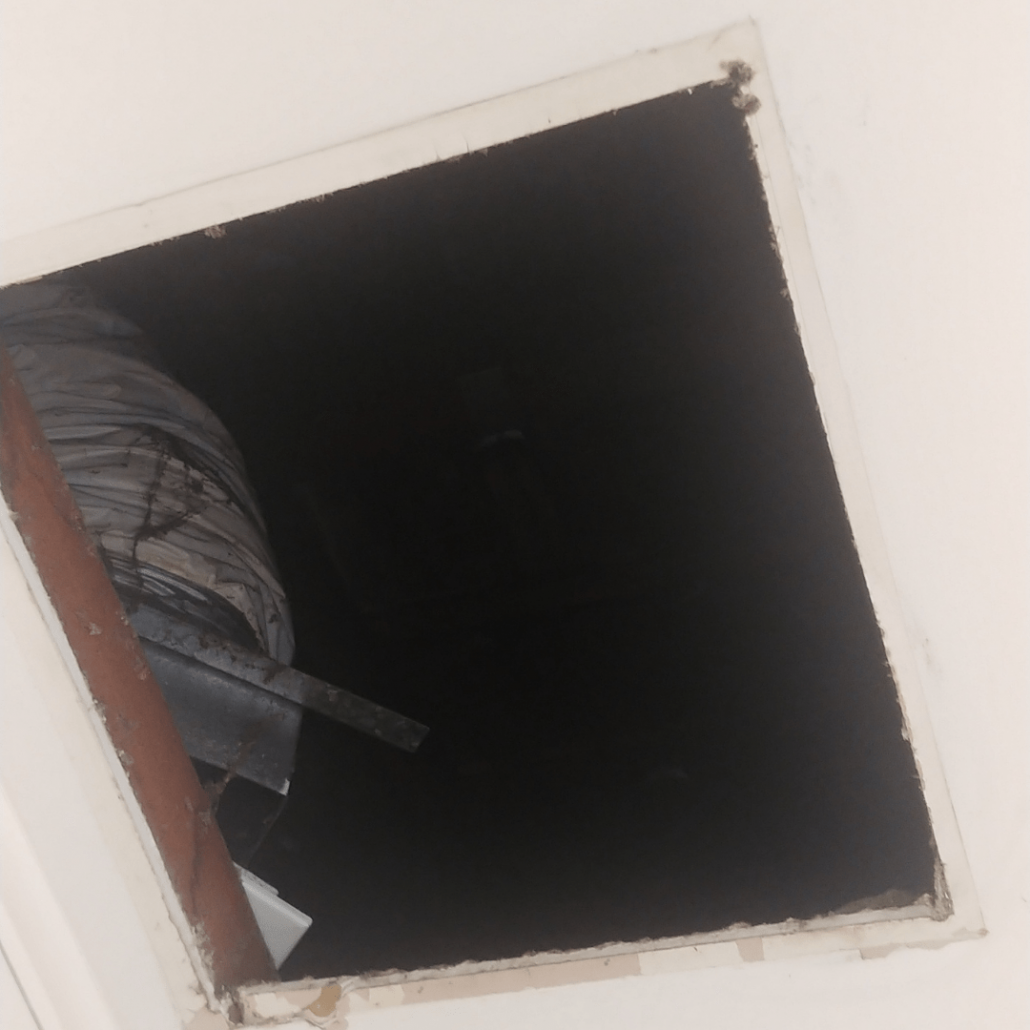
And then repaint the ceilings.
It’s hard to measure the difference this made, but for a fairly inexpensive job it was worth it.
5. Insulating the roof space
The first winter it was so cold in the house I assumed we didn’t actually have any insulation at all. Turns out we did, but it was old (probably 50 years old), and very thin and tired.
When I first moved in, insulation was on my to-do list, but I couldn’t find anyone willing to quote. It was 18 months later when I called some pest people in because I thought we had possums in the roof, that they suggested changing the insulation because it was soiled and to deter future rodents (by using a less nest-friendly material).
It was a service they offered, so I went with them.
The main decision with insulation is the R value rating, which is a measure of the ability to resist heat flow. (You also see it referenced with double glazing and window materials.) R values for insulation range from 1.5 to 7, with the higher number being better.
In Perth, Brisbane and NSW it’s recommended to use a minimum R4.0 in the ceiling.
In Melbourne, Sydney and Adelaide it’s recommended to use a minimum R6.0 in the ceiling.
The more Rs you use, the more material you use and the more expensive it is.
I went with R5.0. (I got a quote for 4.1 and 5.0, and the difference in price was smaller than I expected. I didn’t get a quote for R6.0, but I half wish I had.)
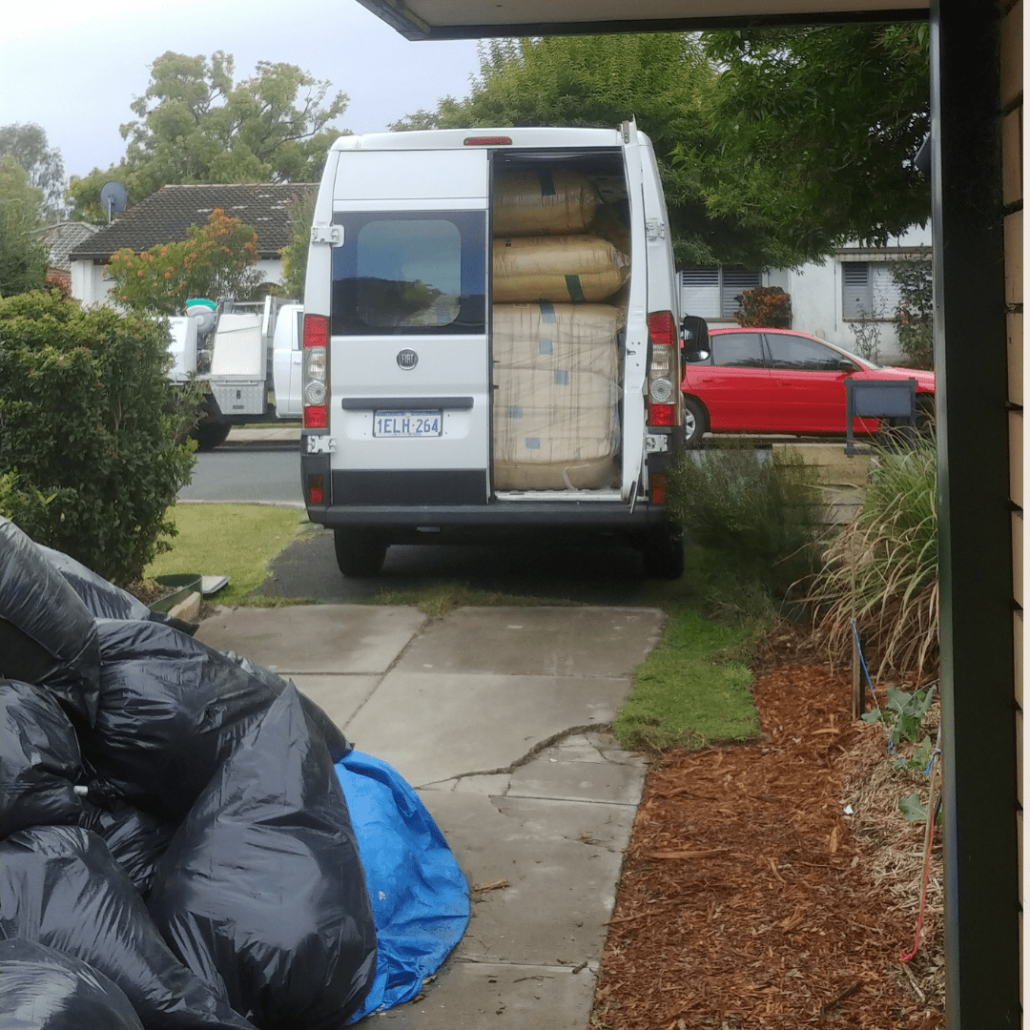
The installers did a great job, removing all the old stuff (and the old air con ducts), vacuuming the roof space and laying the new insulation. I have to say though, I was expecting a more noticeable difference in winter. However, it’s hard to compare as the first winter (with no double glazing or insulation) was fairly mild, and the recent winter (with double glazing and replaced insulation) was much colder and for much longer, so comparing bills isn’t especially useful.
I do wonder if I should have gone with R6.0….
Although I didn’t use the plug-in heater in the office the second year, despite the colder outside temperature, so there was definitely some benefit.
6. Painting the roof white
Both the colour and the material of a roof can affect the energy efficiency of a house.
My home had dark concrete roof tiles. Concrete absorbs heat, and the dark colour increases this. (Studies have shown that dark tiles can increase the air temperature of a roof space by 9°C compared to light tiles.) This means my roof space got very hot, particularly in the early evening as the heat is released into the house.
I can’t change the material the roof is made from (aside from the huge cost, my house is a duplex/semi-detached, so my neighbour would have to want to change her roof too).
But I can change the colour.
You can buy reflective paints for roofs, which are meant to reflect heat. My painter – who definitely had a few opinions on things – ranted that these were a big con and didn’t work and wouldn’t use them.
So I used regular external paint. I wanted to paint the roof white, but the painter suggested an off-white colour. I went with Taubmans ‘martini’, which in the brochure looked kind of beige, but on my roof appears pretty much white.

7. Installing a whirlybird
A whirlybird, also known as a turbine vent, is a cyclindrical dome that spins in the wind, which creates a vacuum that extracts warm air from the roof cavity. They don’t need a lot of wind to spin; even when it appears still outside, the whirlybird still whirls.
Because I have concrete roof tiles that absorb heat during the hot days and release it into my roof space in the evening, the house gets hotter even as the air outside cools. The whirlybird releases this heat outside. If I had a metal roof it would possibly be less effective than with tiles, as metal doesn’t hold heat in the same way.
They are best for hot climates as they also release heat from the roof space in winter. (With good insulation, hopefully the heat from the house is not escaping into the roof space, though.)
They are not expensive to buy (around $100 AUD) and are installed by just placing under the tiles, no special tools required.

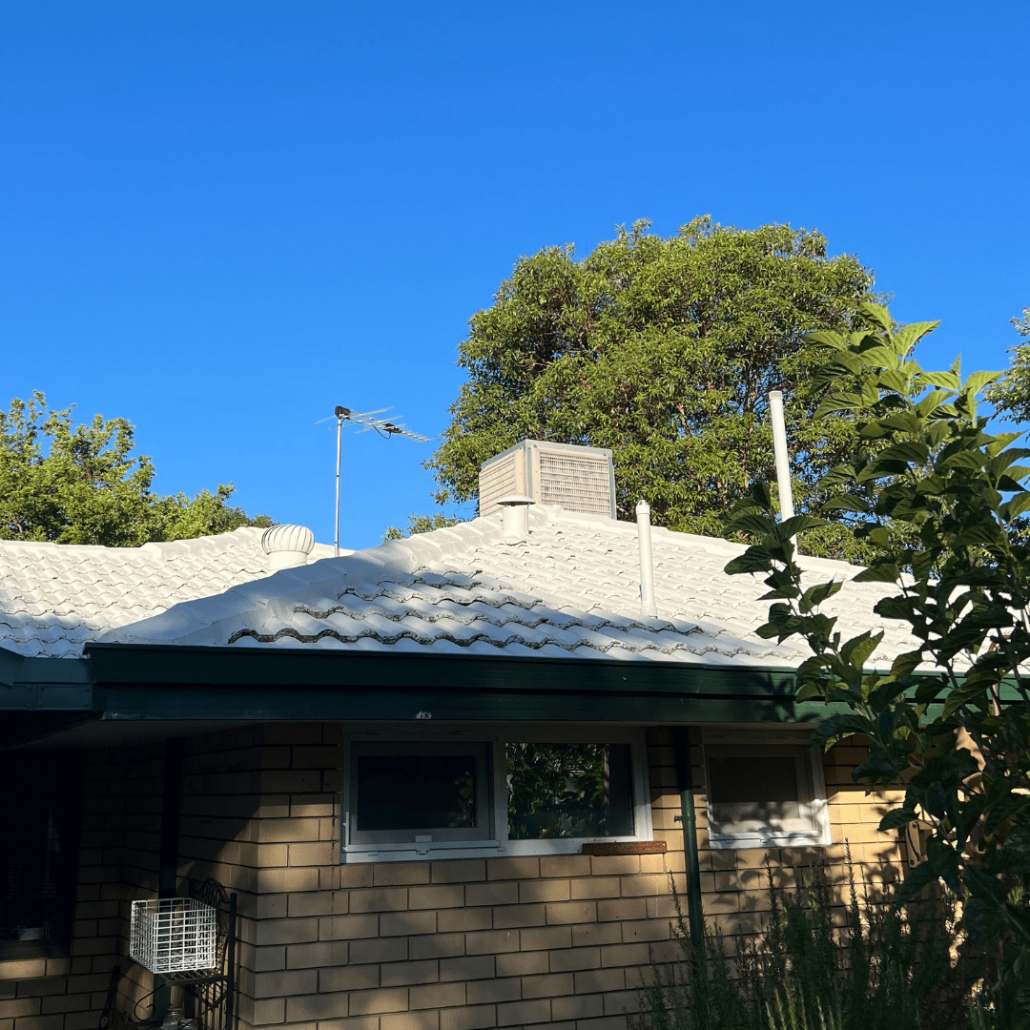
When I painted my roof, the painter also installed the whirlybird for me or no extra charge.
What’s next?
There are a few improvements still to be made, when I have the time and money:
Curtains. I have blinds on most of the windows, but I want to replace them with proper curtains that will do a much better job of keeping the heat in during the winter months.
The kitchen window. This is still the original single glazed glass with an aluminium frame. Knocking through a door into the garden (and renovating the original 1970s kitchen) will be a big and expensive job, so it’s not happening any time soon. But once it’s done it will really make a difference.
The kitchen skylight. The kitchen also has an original skylight that funnels heat in from outside, and it’s placed where the afternoon sun hits for extra heat.
The floors. Something I’m still thinking about, is changing the kitchen floor from laminate to tiles. Tiles have good thermal mass, so absorb heat, whereas laminate does nothing to assist with the room temperature. Thar’s why floors in hot countries are often finished with tiles.
Kitchen benchtop. I have a laminate benchtop, but switching this to stone or concrete will add more thermal mass to the room and help absorb the extra heat.
The garage. This was semi-converted to a room by the previous owners (by which I mean, they painted the walls and laid carpet). But it still has a single glazed glass door with an inch gap at the bottom, and the original metal garage door which incinerates the space in summer (and also has an inch gap at the bottom). I’m not sure what to do with the garage yet – whether to convert it properly into a room (which would be expensive and need planning approval), or simply change all the doors. But because there is an internal door from the garage into the house, the temperature of the garage influences the temperature of the house, so it will definitely need modifying in some way.
…
As for the costs, and the savings? That’s another whole conversation, which I’m saving for another day sometime soon. Plus I’ll talk about what you can do if you rent or are on a tight budget that doesn’t allow for big changes like double glazing. Trust me, you still have options!
As I said at the start, adapting will look different for all of us.
Now I’d love to hear from you! Is the climate changing where you live, and have you been able to make adaptions to better ‘weather’ it? Or do you have plans to do so? Perhaps you’d like to but not sure where to start? Any tips you’d like to add to this? Please share your thoughts in the comments below!
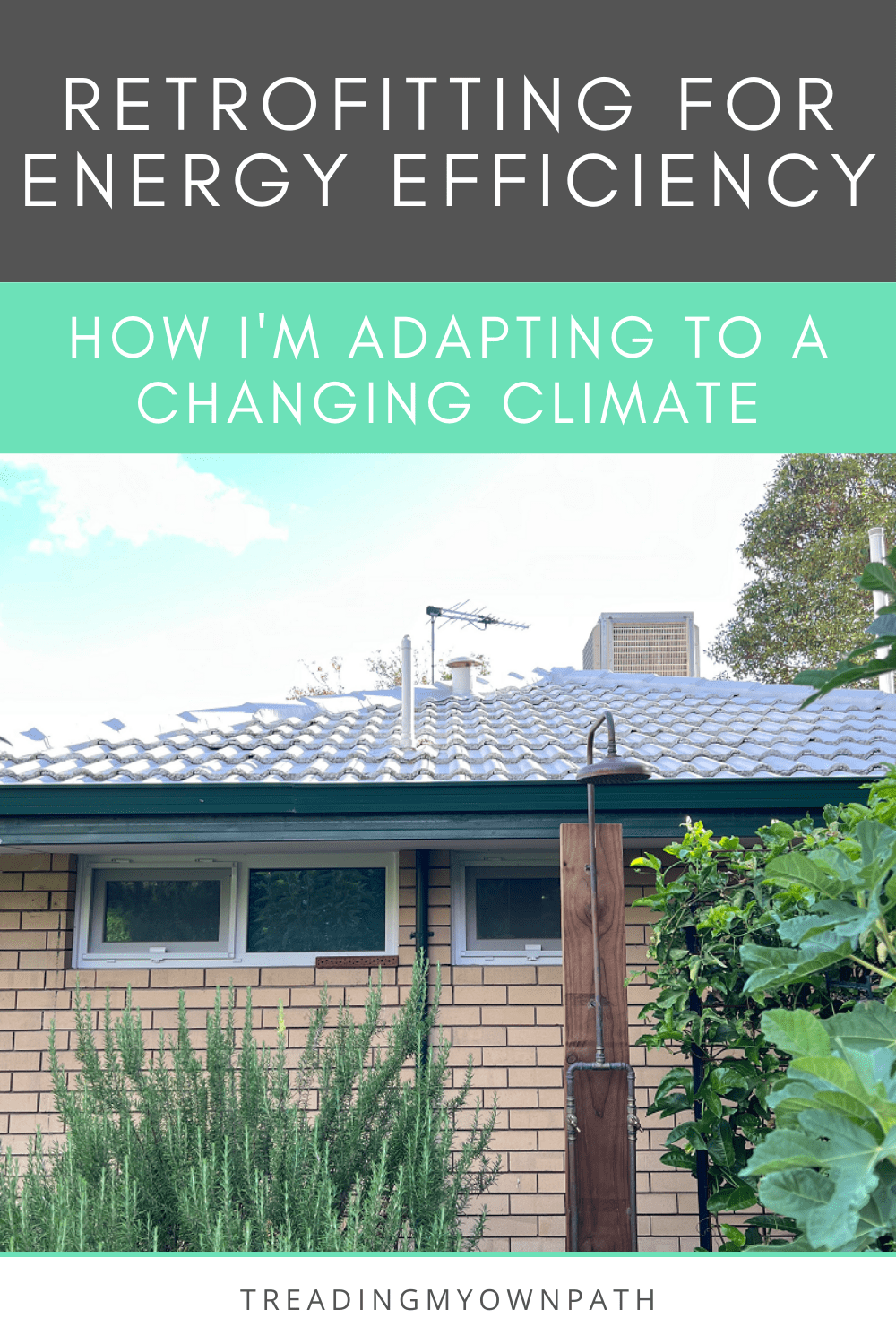







Great to read this. I also have a 70s brick house and am very interested in double-glazing. Crazy that it’s not common here in Australia!
Double glazing has been life-changing, Claire! Honestly. Before, in summer, we would turn the air con off and then five minutes later have to turn it back on again. Now the house stays comfortable. I’m only really using the air con on the high 30s and 40 degree days.
This was a really interesting read Lindsay.
I live in the northern part of North Island in Aotearoa/New Zealand. Its heating up here too. We have had droughts for the last three years.
My poor woman’s solution for keeping heat in in winter is plastic window wrap by 3M from hardware stores for about NZ$35.00 for an average sized 3x4m room with windows on two sides. It seals to the window frame (in my case, timber) with double sided tape, and then you heat it with a blow drier to stretch the plastic tight. It makes an overnight difference of about 10degC compared to rooms in my house with unwrapped windows.
Its only just occurred to me that I could replace the wrapping at season change and keep it through summer keeping the heat out of my west facing bedroom. How dumb have I been!
Cheers for your good work.
Thanks for this great tip Wendy! A friend of mine who rents told me that those thermal blankets the ones that are plastic but look like metal that they use in rescues etc) are great for reflecting heat in summer. Apparently when you put them on glass they still allow light in whilst reflecting heat. She doesn’t have air con either and says it makes a huge difference.
Hi Lindsay,
we redid all the insulation of our 1950s German house (better windows and frames, although the house did have double glazing everywhere except in the basement), put insulation on the exterior walls and insulated the roof (plus added windows and floor to make a bedroom under the roof). This made a huge difference especially in winter as our bricks were cheap post-war material.
Before, we often made a fire in our wood-stove but since then basically never.
I will look into solar panels and hope to talk the husband into installing at least the small panels.
As we lost our typical German roller shutter due to the insulation I also plan to add better curtains to keep out the cold during the night (when we turn the central heating almost to zero).
No AC or fans needed yet (although many Germans start to buy), but it gets VERY hot under the roof and some people say you should not buy attic apartments because in the future they will be uninhabitable.
We still have the basement as an emergency sleeping room!
Cheers from Germany.
Thanks so much for sharing Anita, this is great! I haven’t looked into external insulation, I don’t think it’s very common here at all although I have friends who have DIYed a portion of their house that gets the western afternoon sun. Probably something to add to the investigating list!
As always I am much inspired by your story. Here in the Netherlands we are bracing for cold and wet winters and moderate but still wet summers. We have insulated our house bit by bit and the biggest impact came from floor and outside walls (we have a 1930’s house). Apart from that, you have inspired me to turn my garden into an edible paradise, with fruit trees, berry bushes and a vegetable garden.
Sending you love from Drenthe.
Hi Kyra and thanks for your comment! I really must look into external insulation. I hadn’t really ever thought of it as a thing. But I would love to rely a little less on heating in winter.
So good to hear about your garden, sounds fabulous! Mine is not appreciating the hot hot summer very much at all.
When my youngest was in high school her science teacher assigned a project to build a model house of specific dimensions with a specific amount of windows and doors. The students would then put ice in the house and measure how long it took to melt. My daughter used many of your suggestions in her model—extra insulation, double glazed windows (clear plastic on the inside and outside), curtains, light coloured roof. She was the clear winner. At first the teacher didn’t even believe how well her house worked. She sourced most of her building supplies from scraps used in building new houses in our neighborhood.
Sarah, this is such a cool project/experiment! I absolutely love it. So many people here build without thinking at all about the climate, with black roofs and no eaves and heaps of glass facing the west (peak afternoon sun and heat). I wonder if they realised the implications they’d still do it? If only they all made these models in school!
I’m sure most people who make these choices simply aren’t aware what the implications are for comfort and liveability and electricity bills…
Yes, hot here in WA cooking today 40 degrees. We installed blinds on or pergola, trees and large shrubs on the boundary fences. Inside we have air con , insulation, blinds and curtains. A sky light in the kitchen with a shade built in.We also have a stone bench top which is very cooling and holds the cold from air con.floors are tiles and wooden planks.My parents put in panels on the inside of the garage door as that cuts some heat. Thanks for your wonderful emails I always look forward to them.
Thanks so much for your comment and sharing your ideas! Plants are great for cooling and shade of course, and I’ve done some strategic planting in my garden, but I’ll save that for another post. I’m just waiting until my trees grow tall enough to provide some real shade, ahhhhh……
Great read Lindsay! We added curtains to our home in NSW Southern Highlands – bought secondhand from Gumtree & Facebook Marketplace – 2 bedroom windows and 2 living room windows for less than $500. Planning to eventually add solar panels and follow your tip of painting our roof a lighter colour. Look forward to reading more from your renovation journey
Hi Claire, thanks for sharing your ideas! I find second-hand curtains really tricky as none of my windows are standard. You are lucky to have been able to find some. I have some blinds that fit inside the glass in the front facing windows but they provide minimal insulation and are more for privacy. Curtains is on my to-do list, but there is so much on my to-do list and not so much in my budget!
Hi Lindsay is your whirley bird quiet? I’ve heard that some can be noisy which would really annoy me.
Hi Louise, interesting question! Mine is completely silent. I didn’t even know they could be noisy! Maybe that’s when they are installed in warehouses that don’t have a roof void. I’ve no idea if you can hear it in my roof space as I haven’t been up there to check. Definitely cannot hear it outside or in the house. And even during winter and the big storms, I didn’t hear a thing!
Thanks Lindsay on sharing your projects.
What’s everyone’s thoughts on window tinting? Too much plastic?
Hi Allison, good question! I think plastic used in this way for a permanent solution that is going to reduce energy bills down the track and make life more comfortable is a justified use of plastic, and of course much more budget-friendly than replacing whole windows! I’ve heard it is quite effective but haven’t looked into it too much.
When you think that all of my window frames are now plastic, well that’s a lot more plastic than the tinting.
Plastic for long term solutions, especially when there aren’t other alternatives, seems like a good use of the material to me.
My whirly squeaks but it is an age thing. I had thought about painting the roof, and I am so glad to see you do it. I just found out we have NO insulation in half our ceiling and… I did not know. Face palms
Hi Lindsey,
I love ready your blog. What are your thoughts on rain water tanks in Perth. Perhaps for use in the garden etc?
We’re in the process of slowly, slowly, slowly retrofitting a 1940s house in Perth. Did you have to take down your solar panels to paint the roof, or did the painter paint around them?
Trees to block the strong summer sun coming through the windows
The government built me a brand new disability house which I moved into in 2015. Unfortunately sustainability wasn’t high on their priority list, but I’m lucky to have only one window facing west, which is my office. I keep the blind shut in the afternoon. I love the sun in my north-facing windows in winter. The agency managing the property are great and let me install solar power. I just got my power bill for the last 2 months and it’s the second-highest bill since I had it installed, even with me exporting 751 units! It has been very hot, and my poor dog and support workers feel the heat so keep the air-con on for them. My wall fan above my bed is the best, and I usually sleep well enough with that on (and has a remote so I can turn it on and off). Glad to learn that it doesn’t cost much to run!
Thanks for the interesting post. We live in the middle of England and the front of the house warms up in the summer. We are considering planting runner beans in containers outside the window so that they will shade our house from the heat.
Good post Lindsay, last year we had our concrete tiles repaired and painted a pale apricot colour. This summer hasn’t been as hot as 2019/2020 so I cannot say for sure it has made a huge difference. We have two whirly birds and roof insulation. I did read it isn’t enough to just have the insulation you also need to plug all the gaps. Not as young as we were so my husband isn’t keen on crawling round the roof space to do this, maybe when our grandson gets older? We have planted lots of trees and bushes in our west facing backyard and they do make a noticeable difference. Our biggest problem is huge windows facing west upstairs. We have outside awnings, inside shutters and curtains and upstairs still gets really hot. We have yet to find anyone in Sydney that will quote for double glazing but now we can get around more we may pursue this idea. We are now thinking of putting cladding over the bricks that face west, another thing to look into. Why are building standards so out of tune with the climate? Big question and not easy to answer.
Hi Lindsay, how does the double glazing work with fly screen? We’d like to make use of the Freo Doctor in the afternoons, but live near a lake so we’d need some screen to protect us from mozzies.
Hi Lindsay love your post. I think it really important to start talking about things we do to retrofit improvements to our houses 1) it makes the process normal i.e. everyone will have to change things sooner or later and 2) it shows what is easy or difficult and how people go about it. I think a lot of us have got used to living in homes that they live in without thinking about the impact and we don’t have the first clue about setting out to make greener improvements. All the little things add up and are important. Well done.
The climate is heating up because they are spraying crap in the air, haven’t you noticed? Sustainability is the buzzword of the new world order.
Excelwnt article, some changes I haven’t thought of to consider for my own place (also owner via mortgage) tho strata will hav to be dealt with over some changes, no doubt
Thanks Lindsay for all your insightful tips. As a fellow Perth dweller I have a road map to follow now as our climate heats up. We installed solar panels almost 2 years ago when we bought our unit which faces west and sits in middle if two other units. We have tinted all the west facing windows, installed ceiling fans in every room, put up block out blinds in the main living area and am about to install our whirly bird. Building companies don’t think of sustainability or for that matter good workmanship. So we are struggling trying to fill the gaps they left around doors and windows but we have installed a shade sail in our little alfresco and lots of greenery, as much native as I can fit in. My next project is digging up the pavers in the alfresco and putting in an underground rainwater tank to compliment the other rainwater tanks I have, as well as external blinds for our west facing windows to block more heat. Small steps to mitigate the climbing temperature. You are an inspiration and l always look forward to your posts
Karen Perth
Good stuff Lindsay! If you are looking to get window treatments, I suggest you consider including pelmets. The principle is to stop air circulation; that is, any cool air in winter between the window and drapes/curtains/blinds will drop down and suck warm air in the top. A pelmet can interrupt the flow. (Be sure to ‘seal’ the sides as well). Some folks advocate treatments should go all the way to the floor, I’m not convinced yet.
By the way, venetian blinds are leaky – either vertical or horizontal. In a house not square to the compass vertical venetians can be useful to control sunshine coming in in summer and allowing it in in winter.
While I rave, just a note – the best window treatment is to provide outside shading either with landscaping or shade cloth.
I haven’t read all your correspondence. Feel free to edit.
Thanks, Lindsay for sharing your projects.
What are everyone’s thoughts on window tinting? Too much plastic?
Getting a good high quality air conditioning unit is the primary step to all-round convenience in your house or workplace, air Conditioning Perth